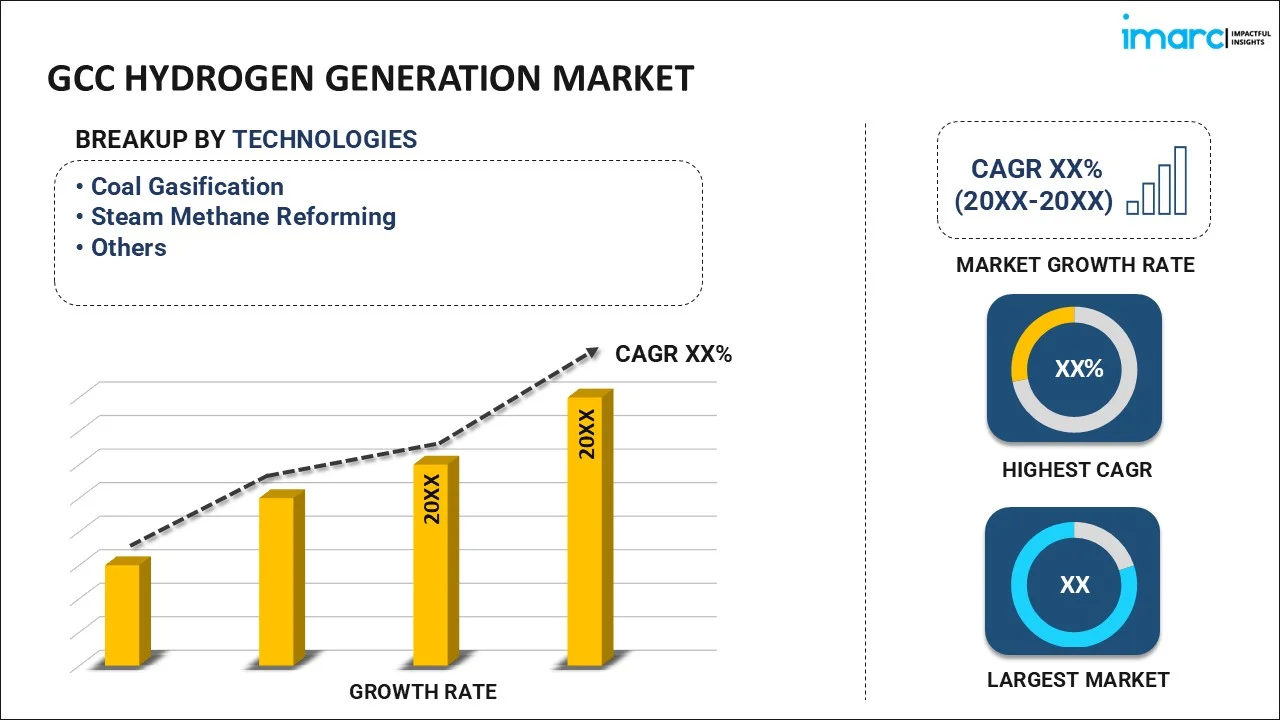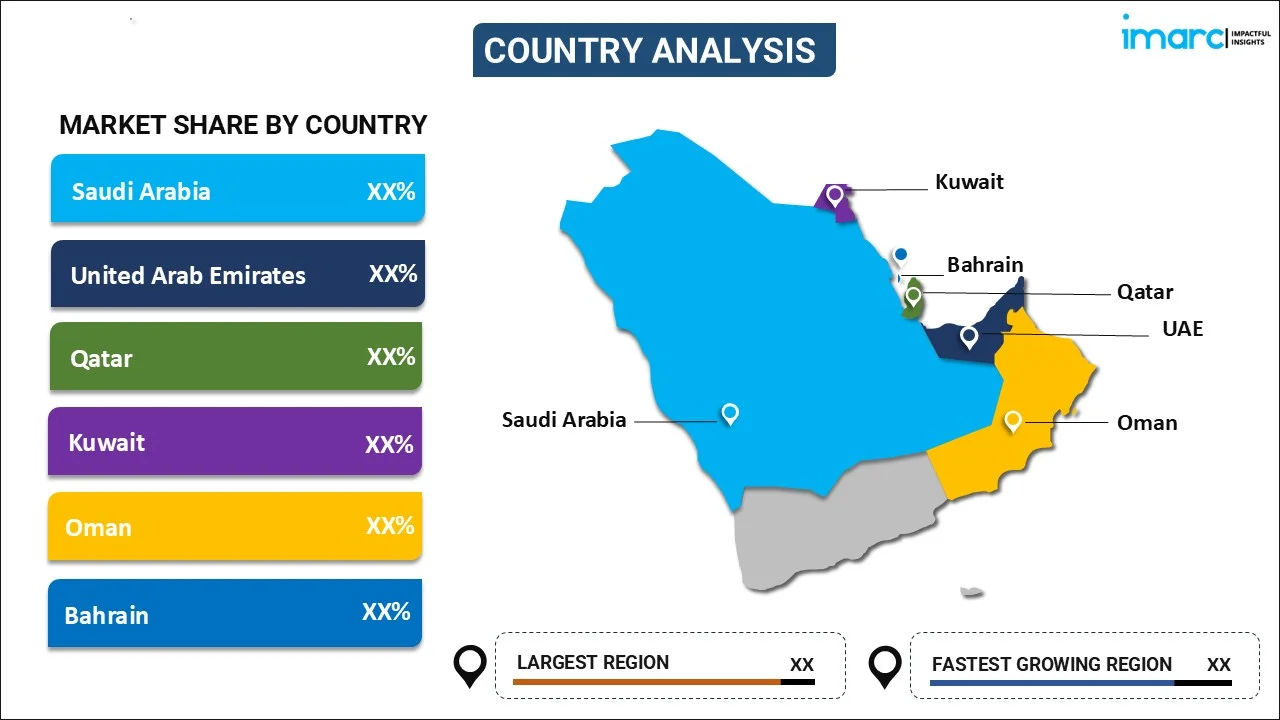
GCC Hydrogen Generation Market Report by Technology (Coal Gasification, Steam Methane Reforming, and Others), Application (Methanol Production, Ammonia Production, Petroleum Refinery, Transportation, Power Generation, and Others), System Type (Merchant, Captive), and Country 2025-2033
Market Overview:
GCC hydrogen generation market size reached USD 4.8 Billion in 2024. Looking forward, IMARC Group expects the market to reach USD 10.1 Billion by 2033, exhibiting a growth rate (CAGR) of 8.27% during 2025-2033. The continuous improvements in electrolysis technologies, such as proton exchange membrane (PEM) and alkaline electrolysis, which contribute to increased efficiency and reduced costs, are driving the market.
|
Report Attribute
|
Key Statistics
|
|---|---|
|
Base Year
|
2024
|
|
Forecast Years
|
2025-2033
|
|
Historical Years
|
2019-2024
|
|
Market Size in 2024
|
USD 4.8 Billion |
|
Market Forecast in 2033
|
USD 10.1 Billion |
| Market Growth Rate 2025-2033 | 8.27% |
Hydrogen generation refers to the process of producing hydrogen gas from various sources, a crucial step in advancing clean energy technologies. The primary methods include steam methane reforming, electrolysis, and biomass conversion. Steam methane reforming involves extracting hydrogen from natural gas, while electrolysis uses an electric current to split water into hydrogen and oxygen. Biomass conversion utilizes organic materials to produce hydrogen through thermochemical or biological processes. Hydrogen, known for its versatility and potential as a clean fuel, can be employed in fuel cells for electricity generation or as a clean energy carrier in transportation. Advancements in hydrogen generation technologies play a vital role in transitioning towards a sustainable and low-carbon energy future, addressing environmental concerns and fostering a more efficient and eco-friendly energy landscape.
GCC Hydrogen Generation Market Trends:
The hydrogen generation market in GCC is experiencing significant growth, primarily driven by various factors that collectively underscore the increasing importance of hydrogen as a clean and versatile energy carrier. To begin with, the growing regional emphasis on decarbonization and the urgent need to combat climate change have fueled interest in hydrogen as a green alternative to traditional fossil fuels. Moreover, stringent environmental regulations and commitments to reduce carbon emissions by governments in the GCC further propel the demand for hydrogen generation technologies. Furthermore, the integration of hydrogen in various sectors, such as transportation, industry, and power generation, acts as a key driver for market expansion. As industries seek cleaner and more sustainable solutions, hydrogen emerges as a pivotal component of the energy transition. The rising adoption of fuel cell vehicles and the push towards a hydrogen-based economy contributes significantly to the increasing demand for hydrogen production technologies. Additionally, advancements in electrolysis and other innovative methods for hydrogen production enhance efficiency and reduce costs, making hydrogen more economically viable. Collaborations between governments, industries, and research institutions to promote R&D initiatives also play a crucial role in fostering the growth of the hydrogen generation market. In conclusion, a confluence of environmental awareness, regulatory pressures, technological advancements, and collaborative efforts are propelling the regional hydrogen generation market toward a promising future.
GCC Hydrogen Generation Market Segmentation:
IMARC Group provides an analysis of the key trends in each segment of the market, along with forecasts at the regional and country levels for 2025-2033. Our report has categorized the market based on technology, application, and system type.
Technology Insights:

- Coal Gasification
- Steam Methane Reforming
- Others
The report has provided a detailed breakup and analysis of the market based on the technology. This includes coal gasification, steam methane reforming, and others.
Application Insights:
- Methanol Production
- Ammonia Production
- Petroleum Refinery
- Transportation
- Power Generation
- Others
A detailed breakup and analysis of the market based on the application have also been provided in the report. This includes methanol production, ammonia production, petroleum refinery, transportation, power generation, and others.
System Type Insights:
- Merchant
- Captive
The report has provided a detailed breakup and analysis of the market based on the system type. This includes merchant and captive.
Country Insights:

- Saudi Arabia
- United Arab Emirates
- Qatar
- Kuwait
- Oman
- Bahrain
The report has also provided a comprehensive analysis of all the major regional markets, which include Saudi Arabia, United Arab Emirates, Qatar, Kuwait, Oman, and Bahrain.
Competitive Landscape:
The market research report has also provided a comprehensive analysis of the competitive landscape in the market. Competitive analysis such as market structure, key player positioning, top winning strategies, competitive dashboard, and company evaluation quadrant has been covered in the report. Also, detailed profiles of all major companies have been provided.
GCC Hydrogen Generation Market Report Coverage:
| Report Features | Details |
|---|---|
| Base Year of the Analysis | 2024 |
| Historical Period | 2019-2024 |
| Forecast Period | 2025-2033 |
| Units | Billion USD |
| Scope of the Report | Exploration of Historical Trends and Market Outlook, Industry Catalysts and Challenges, Segment-Wise Historical and Future Market Assessment:
|
| Technologies Covered | Coal Gasification, Steam Methane Reforming, Others |
| Applications Covered | Methanol Production, Ammonia Production, Petroleum Refinery, Transportation, Power Generation, Others |
| System Types Covered | Merchant, Captive |
| Countries Covered | Saudi Arabia, United Arab Emirates, Qatar, Kuwait, Oman, Bahrain |
| Customization Scope | 10% Free Customization |
| Post-Sale Analyst Support | 10-12 Weeks |
| Delivery Format | PDF and Excel through Email (We can also provide the editable version of the report in PPT/Word format on special request) |
Key Questions Answered in This Report:
- How has the GCC hydrogen generation market performed so far and how will it perform in the coming years?
- What has been the impact of COVID-19 on the GCC hydrogen generation market?
- What is the breakup of the GCC hydrogen generation market on the basis of technology?
- What is the breakup of the GCC hydrogen generation market on the basis of application?
- What is the breakup of the GCC hydrogen generation market on the basis of system type?
- What are the various stages in the value chain of the GCC hydrogen generation market?
- What are the key driving factors and challenges in the GCC hydrogen generation?
- What is the structure of the GCC hydrogen generation market and who are the key players?
- What is the degree of competition in the GCC hydrogen generation market?
Key Benefits for Stakeholders:
- IMARC’s industry report offers a comprehensive quantitative analysis of various market segments, historical and current market trends, market forecasts, and dynamics of the GCC hydrogen generation market from 2019-2033.
- The research report provides the latest information on the market drivers, challenges, and opportunities in the GCC hydrogen generation market.
- Porter's five forces analysis assist stakeholders in assessing the impact of new entrants, competitive rivalry, supplier power, buyer power, and the threat of substitution. It helps stakeholders to analyze the level of competition within the GCC hydrogen generation industry and its attractiveness.
- Competitive landscape allows stakeholders to understand their competitive environment and provides an insight into the current positions of key players in the market.
Need more help?
- Speak to our experienced analysts for insights on the current market scenarios.
- Include additional segments and countries to customize the report as per your requirement.
- Gain an unparalleled competitive advantage in your domain by understanding how to utilize the report and positively impacting your operations and revenue.
- For further assistance, please connect with our analysts.
 Request Customization
Request Customization
 Speak to an Analyst
Speak to an Analyst
 Request Brochure
Request Brochure
 Inquire Before Buying
Inquire Before Buying




.webp)




.webp)












